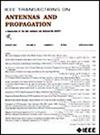A Novel Continuous Direct Antenna Modulation System Through Varactor Diode Tuning
IF 4.6
1区 计算机科学
Q1 ENGINEERING, ELECTRICAL & ELECTRONIC
引用次数: 0
Abstract
In this article, we propose and evaluate a direct antenna modulation (DAM) system. We attempt to bypass the upper bound on an efficiency bandwidth product (EBP) for an electrically small antenna (ESA), which is related to the lower bound on antenna Q established by Wheeler and Chu. We do this by using a time-varying system, breaking the time-invariance assumed in the derivation of these bounds. There is thus potential to see an EBP that exceeds the limitation for an antenna of a given size. The proposed antenna is based on a top-loaded monopole antenna and then utilizes varactor diodes to continuously vary the resonance frequency of the antenna as a function of time. We use a frequency-modulated (FM) input signal that is synchronous to the tuning of the antenna resonance, matching the instantaneous frequency of the input signal to the current resonance of the antenna, thus enabling the transmission of an arbitrary FM signal. We evaluate the performance of the antenna through the use of full-wave solver simulations, equivalent circuit model simulations, and prototype measurements. We demonstrate through both simulation and physical measurements that time variation in the antenna synchronized with the input signal improves the EBP of the antenna in comparison to the linear time-invariant (LTI) case.通过变容二极管调谐的新型连续直接天线调制系统
在本文中,我们提出并评估了一个直接天线调制(DAM)系统。我们试图绕过电小天线(ESA)的效率带宽积(EBP)的上界,这与Wheeler和Chu建立的天线Q的下界有关。我们通过使用时变系统来做到这一点,打破了在这些界的推导中假设的时不变。因此,有可能看到EBP超过给定尺寸天线的限制。所提出的天线基于顶载单极天线,然后利用变容二极管连续改变天线的谐振频率作为时间的函数。我们使用与天线谐振调谐同步的调频(FM)输入信号,使输入信号的瞬时频率与天线的当前谐振相匹配,从而实现任意调频信号的传输。我们通过使用全波求解器仿真、等效电路模型仿真和原型测量来评估天线的性能。我们通过仿真和物理测量证明,与线性时不变(LTI)情况相比,与输入信号同步的天线时间变化改善了天线的EBP。
本文章由计算机程序翻译,如有差异,请以英文原文为准。
求助全文
约1分钟内获得全文
求助全文
来源期刊
CiteScore
10.40
自引率
28.10%
发文量
968
审稿时长
4.7 months
期刊介绍:
IEEE Transactions on Antennas and Propagation includes theoretical and experimental advances in antennas, including design and development, and in the propagation of electromagnetic waves, including scattering, diffraction, and interaction with continuous media; and applications pertaining to antennas and propagation, such as remote sensing, applied optics, and millimeter and submillimeter wave techniques

 求助内容:
求助内容: 应助结果提醒方式:
应助结果提醒方式:


